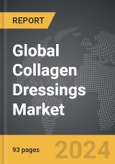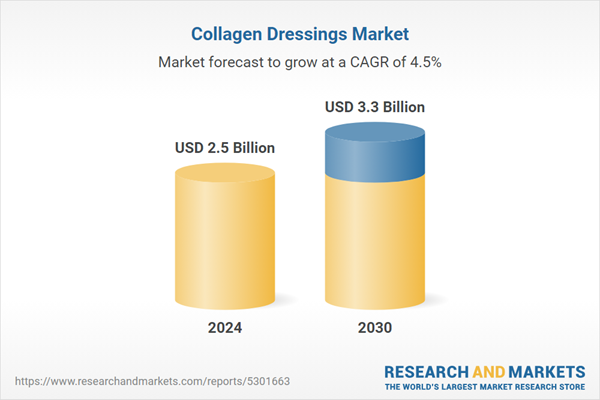Global Collagen Dressings Market - Key Trends & Drivers Summarized
What Are Collagen Dressings & Why Are They Crucial for Wound Healing?
Collagen dressings are specialized wound care products that contain collagen, a natural protein found in skin, connective tissue, and bones, which plays a critical role in wound healing and tissue regeneration. Collagen dressings promote the growth of new tissue, support cell migration, and help manage moisture levels in wounds. These dressings are available in various forms, including sheets, pads, gels, powders, and pastes, allowing for versatile application depending on the wound type and location. Collagen dressings are commonly used to treat a variety of wounds, such as pressure ulcers, diabetic foot ulcers, venous leg ulcers, surgical wounds, and second-degree burns, as they help accelerate the healing process and minimize scarring.The demand for collagen dressings has risen significantly due to their effectiveness in managing complex and chronic wounds that are difficult to heal with conventional treatments. By providing a moist wound environment and acting as a scaffold for new tissue growth, collagen dressings reduce healing time, lower infection risk, and improve overall outcomes for patients with acute and chronic wounds. With the aging global population, increasing rates of diabetes, and a growing incidence of chronic wounds, collagen dressings have become an essential component of advanced wound care. The ability of collagen dressings to facilitate faster healing and reduce the need for frequent dressing changes makes them a preferred choice among healthcare professionals for treating both acute and non-healing wounds.
How Do Collagen Dressings Enhance Wound Healing & Improve Patient Outcomes?
Collagen dressings enhance wound healing by providing structural support and promoting the natural wound healing cascade. Collagen attracts fibroblasts and keratinocytes to the wound site, supporting the formation of granulation tissue, which is essential for wound closure. By acting as a matrix for cell attachment, collagen dressings facilitate cell migration and new tissue formation, accelerating the healing process. Additionally, collagen's natural moisture-retention properties help maintain an optimal moist wound environment, which is known to promote faster epithelialization and reduce the risk of desiccation or tissue necrosis. This moist environment also supports autolytic debridement, where the body's enzymes break down dead tissue, further promoting healing and reducing the risk of infection.For patients with chronic wounds, such as diabetic ulcers or pressure sores, collagen dressings have proven to be highly effective in reducing wound size, decreasing pain, and minimizing the potential for infection. These dressings also help to reduce excessive matrix metalloproteinases (MMPs), enzymes that can break down the extracellular matrix and delay healing in chronic wounds. By neutralizing MMPs, collagen dressings create a more favorable wound environment, facilitating better outcomes. For surgical wounds, collagen dressings help manage exudate and prevent complications such as infection and dehiscence (wound reopening), supporting faster post-operative recovery. The use of collagen dressings has been associated with improved patient outcomes, reduced healing times, and lower healthcare costs by minimizing the need for additional interventions and reducing hospital stays.
How Are Technological Advancements Shaping the Development of Collagen Dressings?
Technological advancements have significantly improved the formulation, efficacy, and versatility of collagen dressings, making them more effective in wound care management. One of the major innovations in this field is the development of bioengineered collagen, derived from various sources such as bovine, porcine, equine, or fish, which ensures higher biocompatibility and reduced risk of allergic reactions. Additionally, advancements in processing techniques have enabled the production of purer collagen with better stability and absorption, enhancing its effectiveness in wound healing. Manufacturers have also developed cross-linked collagen dressings that offer enhanced durability and longer-lasting moisture retention, making them suitable for treating chronic wounds with heavy exudate.Another significant advancement is the integration of antimicrobial agents, growth factors, or other biologically active compounds into collagen dressings. These combination dressings not only promote faster tissue regeneration but also reduce the risk of wound infections by inhibiting bacterial growth. For instance, collagen dressings infused with silver or honey provide both antimicrobial protection and support for tissue growth, making them particularly useful in managing infected or high-risk wounds. The use of nanotechnology in collagen dressings has also enhanced their capabilities by improving the delivery of active ingredients, increasing surface area for better absorption, and allowing for more controlled release of healing agents. Additionally, the development of collagen hydrogels and foams has expanded the applicability of collagen-based products, offering better flexibility, conformability, and patient comfort. These technological innovations have not only improved the performance of collagen dressings but also expanded their use across different wound types and healthcare settings.
What Factors Are Driving Growth in the Collagen Dressings Market?
The growth in the collagen dressings market is driven by several factors, including the increasing prevalence of chronic wounds, the rising geriatric population, advancements in wound care technology, and growing awareness of advanced wound management. Chronic wounds, such as diabetic foot ulcers, venous leg ulcers, and pressure ulcers, are becoming more common due to the global rise in diabetes, obesity, and aging populations. These wounds often require specialized treatment to prevent complications, making collagen dressings a preferred choice for healthcare providers. The effectiveness of collagen dressings in managing exudate, promoting faster healing, and reducing infection risk has contributed to their growing adoption in hospitals, outpatient facilities, and home healthcare settings.Another significant driver is the shift toward value-based healthcare, where reducing treatment costs and improving patient outcomes are key priorities. Collagen dressings help achieve these goals by accelerating wound healing, reducing the need for frequent dressing changes, and minimizing hospital stays, thereby lowering overall healthcare costs. The growing awareness of advanced wound care solutions among healthcare professionals and patients has also supported market growth, as more people seek effective treatments for complex wounds. Government initiatives and reimbursement policies in many developed countries have further encouraged the use of advanced wound care products, including collagen dressings. Additionally, the expanding use of collagen dressings in emerging markets, driven by improved healthcare infrastructure and increasing healthcare expenditures, presents new growth opportunities for manufacturers. With ongoing innovations and rising demand for effective wound care solutions, the collagen dressings market is poised for sustained growth, supported by demographic trends, technological advancements, and healthcare reforms focused on better outcomes.
Report Scope
The report analyzes the Collagen Dressings market, presented in terms of market value (US$ Thousand). The analysis covers the key segments and geographic regions outlined below.- Segments: Dressing Type (Antimicrobial Collagen Dressings, Alginate Collagen Dressings, Hydrogel Collagen Dressings, Native Collagen Dressings, Other Dressing Types); Application (Acute Wounds, Chronic Wounds); End-Use (Hospitals, Ambulatory Surgery Centers, Clinics, Other End-Uses).
- Geographic Regions/Countries:World; United States; Canada; Japan; China; Europe (France; Germany; Italy; United Kingdom; Spain; Russia; and Rest of Europe); Asia-Pacific (Australia; India; South Korea; and Rest of Asia-Pacific); Latin America (Argentina; Brazil; Mexico; and Rest of Latin America); Middle East (Iran; Israel; Saudi Arabia; United Arab Emirates; and Rest of Middle East); and Africa.
Key Insights:
- Market Growth: Understand the significant growth trajectory of the Antimicrobial Collagen Dressings segment, which is expected to reach US$1.2 Billion by 2030 with a CAGR of a 5.1%. The Alginate Collagen Dressings segment is also set to grow at 4.3% CAGR over the analysis period.
- Regional Analysis: Gain insights into the U.S. market, valued at $677.7 Million in 2024, and China, forecasted to grow at an impressive 7.6% CAGR to reach $699.7 Million by 2030. Discover growth trends in other key regions, including Japan, Canada, Germany, and the Asia-Pacific.
Why You Should Buy This Report:
- Detailed Market Analysis: Access a thorough analysis of the Global Collagen Dressings Market, covering all major geographic regions and market segments.
- Competitive Insights: Get an overview of the competitive landscape, including the market presence of major players across different geographies.
- Future Trends and Drivers: Understand the key trends and drivers shaping the future of the Global Collagen Dressings Market.
- Actionable Insights: Benefit from actionable insights that can help you identify new revenue opportunities and make strategic business decisions.
Key Questions Answered:
- How is the Global Collagen Dressings Market expected to evolve by 2030?
- What are the main drivers and restraints affecting the market?
- Which market segments will grow the most over the forecast period?
- How will market shares for different regions and segments change by 2030?
- Who are the leading players in the market, and what are their prospects?
Report Features:
- Comprehensive Market Data: Independent analysis of annual sales and market forecasts in US$ Million from 2024 to 2030.
- In-Depth Regional Analysis: Detailed insights into key markets, including the U.S., China, Japan, Canada, Europe, Asia-Pacific, Latin America, Middle East, and Africa.
- Company Profiles: Coverage of players such as 3M, Angelini S.p.a., BSN Medical, Coloplast Corporation, Covalon Technologies Ltd and more.
- Complimentary Updates: Receive free report updates for one year to keep you informed of the latest market developments.
Some of the 42 companies featured in this Collagen Dressings market report include:
- 3M
- Angelini S.p.a.
- BSN Medical
- Coloplast Corporation
- Covalon Technologies Ltd
- DermaRite Industries LLC
- Hollister Incorporated
- Human BioSciences
- Integra Lifesciences Corporation
- Medline Industries Inc.
- Organogenesis Inc.
- Smith & Nephew
This edition integrates the latest global trade and economic shifts into comprehensive market analysis. Key updates include:
- Tariff and Trade Impact: Insights into global tariff negotiations across 180+ countries, with analysis of supply chain turbulence, sourcing disruptions, and geographic realignment. Special focus on 2025 as a pivotal year for trade tensions, including updated perspectives on the Trump-era tariffs.
- Adjusted Forecasts and Analytics: Revised global and regional market forecasts through 2030, incorporating tariff effects, economic uncertainty, and structural changes in globalization. Includes historical analysis from 2015 to 2023.
- Strategic Market Dynamics: Evaluation of revised market prospects, regional outlooks, and key economic indicators such as population and urbanization trends.
- Innovation & Technology Trends: Latest developments in product and process innovation, emerging technologies, and key industry drivers shaping the competitive landscape.
- Competitive Intelligence: Updated global market share estimates for 2025, competitive positioning of major players (Strong/Active/Niche/Trivial), and refined focus on leading global brands and core players.
- Expert Insight & Commentary: Strategic analysis from economists, trade experts, and domain specialists to contextualize market shifts and identify emerging opportunities.
Table of Contents
Companies Mentioned (Partial List)
A selection of companies mentioned in this report includes, but is not limited to:
- 3M
- Angelini S.p.a.
- BSN Medical
- Coloplast Corporation
- Covalon Technologies Ltd
- DermaRite Industries LLC
- Hollister Incorporated
- Human BioSciences
- Integra Lifesciences Corporation
- Medline Industries Inc.
- Organogenesis Inc.
- Smith & Nephew
Table Information
| Report Attribute | Details |
|---|---|
| No. of Pages | 381 |
| Published | December 2025 |
| Forecast Period | 2024 - 2030 |
| Estimated Market Value ( USD | $ 2.5 Billion |
| Forecasted Market Value ( USD | $ 3.3 Billion |
| Compound Annual Growth Rate | 4.5% |
| Regions Covered | Global |









